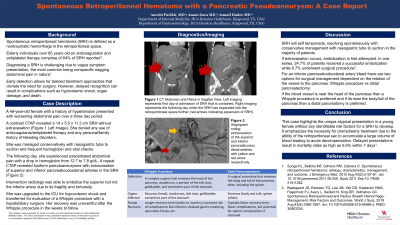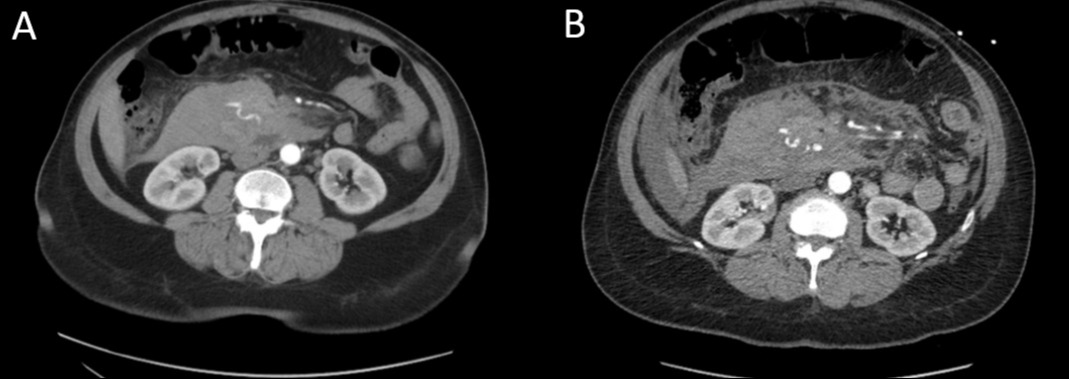Monday Poster Session
Category: GI Bleeding
P2525 - Spontaneous Retroperitoneal Hematoma With a Peripancreatic Pseudoaneurysm: A Case Report
Monday, October 28, 2024
10:30 AM - 4:00 PM ET
Location: Exhibit Hall E

Has Audio
.jpg)
Aarohi Parikh, MD
HCA Healthcare
Kingwood, TX
Presenting Author(s)
Aarohi Parikh, MD, Anam Zara, MD, Ismail Hader, MD
HCA Healthcare, Kingwood, TX
Introduction: Diagnosing spontaneous retroperitoneal hematoma (SRH), a non-traumatic hemorrhage in the retroperitoneal space, is challenging due to vague symptom presentation. Early detection allows for tailored treatment approaches that obviate the need for surgery. However, delayed recognition can result in complications such as hypovolemic shock, organ damage, and death. We report a case of SRH requiring a Whipple procedure due to extravasation and acute decompensation.
Case Description/Methods: A 46-year-old female with a history of hypertension presented with worsening epigastric pain over three days. Vitals signs were within normal limits, and physical exam was remarkable for epigastric tenderness. Hemoglobin on arrival was 12.5 g/dL, and a contrast computed tomography (CT) scan showed a 14 x 5.5 x 11.3 cm retroperitoneal hematoma without extravasation (Figure 1A). She was initially managed conservatively with hemoglobin monitoring every 6 hours and aggressive resuscitation. The following day, she experienced an exacerbation of abdominal pain and her hemoglobin decreased to 7.8 g/dL. A repeat CT scan revealed fusiform pseudoaneurysms and extravasation of both the superior and inferior pancreaticoduodenal arteries. Interventional radiology successfully embolized the superior, but not the inferior pancreaticoduodenal artery, due to the latter’s tortuosity and fragility, resulting in persistent active bleeding. She was transferred to the intensive care unit for hypovolemic shock requiring massive transfusion protocol, intubation, and vasopressor support. She underwent a successful Whipple procedure, and her recovery was uneventful.
Discussion: SRH commonly affects individuals over 65 years old on anticoagulation therapy. Risk factors include anticoagulant use, vascular abnormalities (arteriosclerosis or aneurysms), unrecognized trauma, or inherited coagulopathy disorders. Conservative management with frequent hemoglobin monitoring, aggressive resuscitation, and nasogastric suction is typically effective due to spontaneous resolution of the bleed. However, if extravasation is observed on imaging, embolization is recommended, followed by surgery if bleeding persists. In this case, ongoing bleeding from the inferior pancreaticoduodenal artery necessitated a Whipple procedure for direct control. Delayed presentations increase mortality rate drastically, highlighting the importance for continuous observation and early recognition.

Disclosures:
Aarohi Parikh, MD, Anam Zara, MD, Ismail Hader, MD. P2525 - Spontaneous Retroperitoneal Hematoma With a Peripancreatic Pseudoaneurysm: A Case Report, ACG 2024 Annual Scientific Meeting Abstracts. Philadelphia, PA: American College of Gastroenterology.
HCA Healthcare, Kingwood, TX
Introduction: Diagnosing spontaneous retroperitoneal hematoma (SRH), a non-traumatic hemorrhage in the retroperitoneal space, is challenging due to vague symptom presentation. Early detection allows for tailored treatment approaches that obviate the need for surgery. However, delayed recognition can result in complications such as hypovolemic shock, organ damage, and death. We report a case of SRH requiring a Whipple procedure due to extravasation and acute decompensation.
Case Description/Methods: A 46-year-old female with a history of hypertension presented with worsening epigastric pain over three days. Vitals signs were within normal limits, and physical exam was remarkable for epigastric tenderness. Hemoglobin on arrival was 12.5 g/dL, and a contrast computed tomography (CT) scan showed a 14 x 5.5 x 11.3 cm retroperitoneal hematoma without extravasation (Figure 1A). She was initially managed conservatively with hemoglobin monitoring every 6 hours and aggressive resuscitation. The following day, she experienced an exacerbation of abdominal pain and her hemoglobin decreased to 7.8 g/dL. A repeat CT scan revealed fusiform pseudoaneurysms and extravasation of both the superior and inferior pancreaticoduodenal arteries. Interventional radiology successfully embolized the superior, but not the inferior pancreaticoduodenal artery, due to the latter’s tortuosity and fragility, resulting in persistent active bleeding. She was transferred to the intensive care unit for hypovolemic shock requiring massive transfusion protocol, intubation, and vasopressor support. She underwent a successful Whipple procedure, and her recovery was uneventful.
Discussion: SRH commonly affects individuals over 65 years old on anticoagulation therapy. Risk factors include anticoagulant use, vascular abnormalities (arteriosclerosis or aneurysms), unrecognized trauma, or inherited coagulopathy disorders. Conservative management with frequent hemoglobin monitoring, aggressive resuscitation, and nasogastric suction is typically effective due to spontaneous resolution of the bleed. However, if extravasation is observed on imaging, embolization is recommended, followed by surgery if bleeding persists. In this case, ongoing bleeding from the inferior pancreaticoduodenal artery necessitated a Whipple procedure for direct control. Delayed presentations increase mortality rate drastically, highlighting the importance for continuous observation and early recognition.

Figure: Figure 1. A. Axial cut of CT abdomen with contrast showing 14 x 5.5 x 11.3 cm spontaneous retroperitoneal hematoma (SRH) without any extravasation. B. Axial cut of CT abdomen with contrast the following day indicating SRH with coiled pseudoaneurysms and extravasation.
Disclosures:
Aarohi Parikh indicated no relevant financial relationships.
Anam Zara indicated no relevant financial relationships.
Ismail Hader indicated no relevant financial relationships.
Aarohi Parikh, MD, Anam Zara, MD, Ismail Hader, MD. P2525 - Spontaneous Retroperitoneal Hematoma With a Peripancreatic Pseudoaneurysm: A Case Report, ACG 2024 Annual Scientific Meeting Abstracts. Philadelphia, PA: American College of Gastroenterology.
